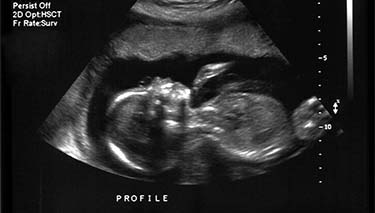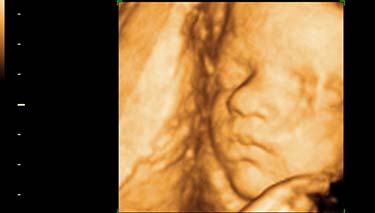What Exactly is an Ultrasound?
An ultrasound is a medical procedure which is otherwise known as a scan. This involves high frequency sound waves transmitted through the body and then picked up on a screen.
During pregnancy, a device known as a transducer is used to move along the mother's abdomen and this sends sound waves via her abdomen and through her uterus. These sound waves bounce off the baby in the form of echoes. A computer picks up the echo messages and translates them onto a screen. As the baby moves and kicks, images can be seen on the ultrasound screen. These sound waves are very high in pitch and intensity and cannot be heard by the human ear.
Most types of ultrasound are a painless and non invasive procedure. However, as you may need to have a full bladder if you are in the early stages of your pregnancy, it can be a little uncomfortable.
Are 2D ultrasounds safe?
Many parents worry about the safety of pregnancy ultrasounds. However, ultrasounds have been used during pregnancy for over 30 years, and to date there is no evidence that they harm either the mother or her baby. Because ultrasound relies on sound waves and not radiation, like X-rays do, they are much less risky.
Ultrasound is not just limited to use during pregnancy but is used for a whole range of medical diagnosis and treatments. Any organ can be visualised by ultrasound, and depending on the skill and expertise of the sonographer, sometimes more invasive and expensive diagnostic procedures can be avoided.
What exactly is a 2D ultrasound?
A 2D ultrasound is the standard procedure used during obstetric ultrasound. It is the one used to produce 2 dimensional images of what is happening inside the mothers and baby's body. Generally, all pregnancy ultrasounds are still done using 2D technology. A baby's gestation, growth, heartbeat, development and size can all be seen clearly using 2D ultrasound. The position of the placenta, cord and lie/position of the baby can also be clearly seen.
The images from a 2d ultrasound tend to be in black and white and have the same level of detail as a photographic negative. Depending on how the baby is lying and their position in the uterus, different images will be seen.
It really is a matter of luck if the baby is awake and active or having a little sleep when the ultrasound is being done. Some mothers choose to have a sweet or cold drink before the procedure or poke their tummy in an effort to stimulate their baby. Sometimes the images are very clear and it's easy for parents to interpret the ultrasound images. At other times, this can be a little more difficult. But don t worry; the sonographer can point out specific organs, features and details of the baby if you're not sure. They can also freeze frame the images, take photos and label different body parts on the screen. With a little explanation, it can all be come a lot clearer!
When are 2D ultrasounds normally done?
At any stage during pregnancy. Some health care practitioners recommend 2D ultrasound very early in gestation to:
- Diagnose a pregnancy.
- Determine if one or more embryos are present.
- Check where the placenta is lying, especially in relation to the mother's cervix.
- Determine if there are any physical abnormalities or birth defects.
- Estimate the period of gestation.
When is the screening for 2D ultrasound usually done?
Between 18-20 weeks of pregnancy. This is the scan which parents tend to look forward to and for many, this is the first time they have seen their baby so clearly. This is also the scan which is designed to check that all is well with the baby and they are developing and growing normally week by week.
If parents wish to know the sex (gender) of their baby, then it is usually clear by this stage of gestation. You may be able to take home a record of the scan, so ask if you can bring along a USB or disc for the sonographer to burn a copy onto.
Do what you can to organise your partner to be with you and request an appointment date which is mutually suitable. If, by some chance any concerns come up, it will help if you have a support person such as your partner with you.
How is a 2D ultrasound done?
A sonographer, who is a health professional especially trained in radiography, will do the ultrasound. Otherwise a radiologist, who is a medical doctor with an additional degree in radiology, will do the procedure. You will probably have a choice regarding where you can go for your 2D ultrasound, but bear in mind, that some X-Ray/Scan clinics specialise in obstetric scans and you may need to travel a little further than just your local clinic.
Another alternative is that you have a scan at your closest maternity hospital or are given a referral to attend a specialist obstetric sonographer. Either way, you will need a referral for your ultrasound from your primary healthcare provider. Medicare rebates will apply and depending on the service provider, you may or may not need to pay a gap fee.
If you are having an early pregnancy 2D ultrasound you will probably be asked to drink a litre or more of water within the hour prior to your scan booking. This is so that your full bladder will help to lift your uterus a little higher in the pelvis. This will make the scan images clearer.
A warm gel will be applied to your tummy and the radiographer will gently place a transducer on top of the gel. This is a slippery, clear and transparent substance which helps to reduce any resistance between the transducer and the skin. It also helps to facilitate a clearer transmission of the sound waves.
You may be able to see the scan on a separate screen or the sonographer will turn their screen around so you can both see it at the same time. They will do alot of measuring and what seems to be frequent stopping, starting and clicking on their keyboard and computer mouse.
Ask them to explain to you what they are looking at and what they are looking for. But be mindful that you don t interrupt their concentration. Doing a 2D ultrasound properly takes focus and attention to detail. Some sonographers prefer to do the procedure and then discuss what they have seen and others are able to talk their way through it.
Some parents are disappointed that their 2D ultrasound is not as clear as they would like it to be and for this reason request a 3D ultrasound.
Transvaginal ultrasound
A transvaginal ultrasound still uses the same technology but in a different way. Instead of the transducer being held against a mother's abdomen, a specially shaped device is inserted into the vagina. It is not as important to have a full bladder for this procedure as the sound waves do not need to travel through as many layers of tissue and muscle. Instead, the sound waves travel through the cervix and straight into the uterus. To reduce the risk of cross infection, the sonographer will apply a disposable condom to the vaginal transducer.
In early pregnancy, a transvaginal ultrasound is a good alternative to abdominal ultrasound as it can provide a much clearer picture of the embryo and its development.
Last Published* July, 2024
*Please note that the published date may not be the same as the date that the content was created and that information above may have changed since.

















